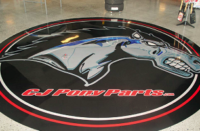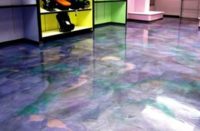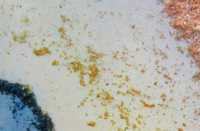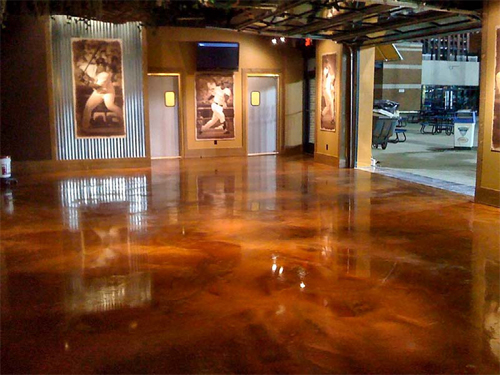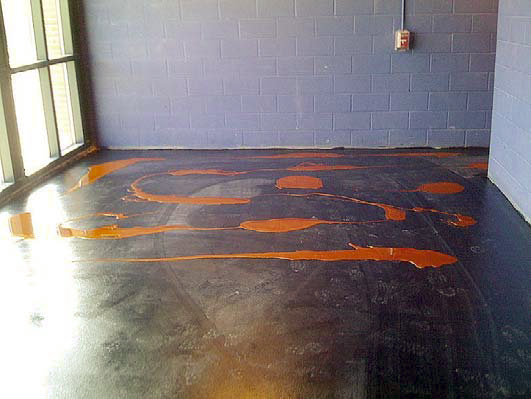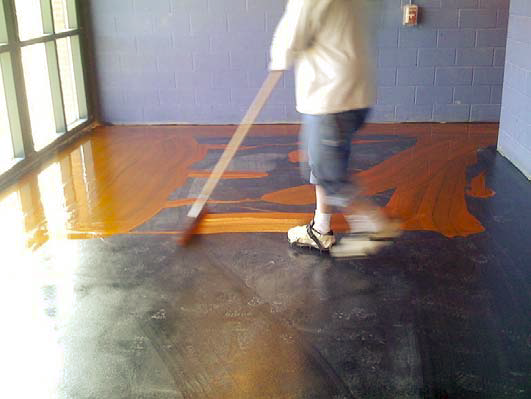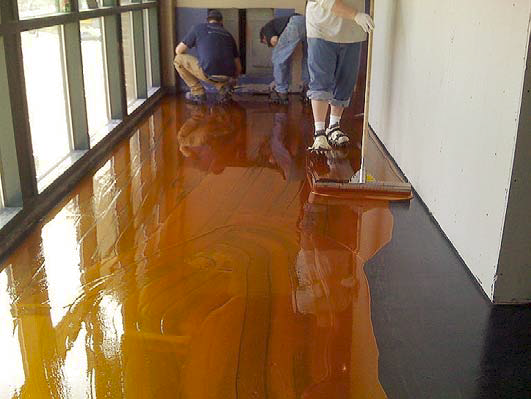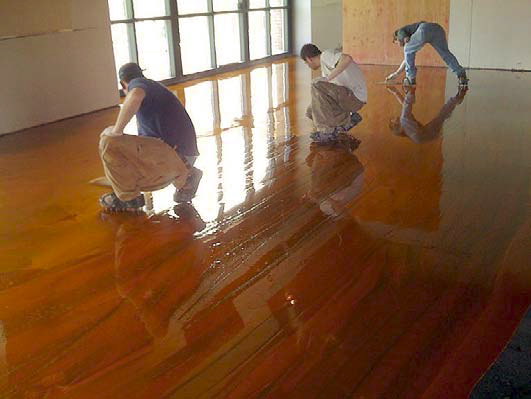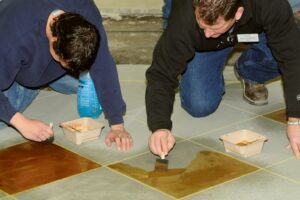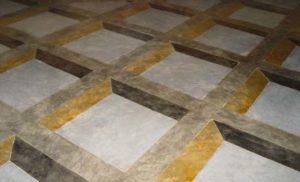Brian Whinnery and Dennis Yurconis, partners at Rochester Hills, Mich.-based Abstract Concrete, are no strangers to bringing life back to buildings in the Detroit area. In fact, hundreds tread on their work daily throughout the interior of the renovated art deco-style Water Board Building in downtown Detroit.
This past spring, the award-winning company stepped up to the plate again, adding the finishing touches to the new Labatt Blue Light Jungle Bar at Comerica Park, where fans of the Detroit Tigers can enjoy a tropical sports dining experience, complete with 119-inch high-definition TVs and 65-inch plasma TVs, plus rain-forest foliage and other theme attractions.
Ilitch Holdings Inc., the architects behind the project, originally wanted to stain the floor of the 3,300-square-foot concrete jungle, but the existing floor wasn’t in the right shape for acid stain, explains Whinnery. When the architects saw samples of Elite Crete Systems Inc.’s Reflector Enhancer, he says they were impressed with the cost, durability and look of the product, and that’s where Whinnery and his team came into play.
“We had the project introduced to us through Ray Rifenberg Sr., the distributor from Elite Crete of Michigan,” he recalls. “He wrote the specs and dealt with the architects through the design phase. He doesn’t do any installation, so he handed it to us.”
Reflector Enhancer is a nonmetallic admixture used to create unique floor finishes that from a distance look like acid stain, but also give off a shimmering effect. The effects come from reflective nanoparticles, each between 10 and 50 microns wide, in 100 percent solids epoxy over an Elite Crete troweled overlay. The product is available in 18 colors that can be blended for almost any look.
Whinnery says he’s been installing concrete with pearlescent powder pigments for years. Though there are similar products on the market (Miracote’s Chameleon Sympony line and Key Resin Co.’s Key Luster Metallic, to name two), he says he likes working with Elite Crete’s system because it doesn’t require a dispersing agent to achieve a patina finish.
“These systems are great because they create such a unique look, at first glance most people think stained concrete, but the floor has so much dimension it really looks like stone,” he says.
With opening day and a NCAA Final Four party looming, Abstract’s team of five installers completed the new floor in just five days (two shy for a typical job of this caliber), but the job didn’t come without its challenges. Whinnery says that several elements of the interior had been remodeled, with walls moved and bar stools torn out, all damaging the existing concrete in different ways.
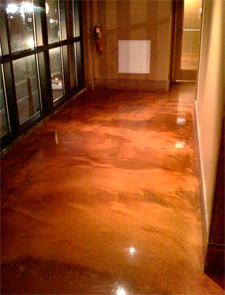 If that wasn’t enough, the concrete was emitting vapors in some areas due to trench work a previous contractor had handled just prior to Abstract’s involvement. “They didn’t use epoxy mortar, so it took longer to cure. Usually we would wait until there are acceptable vapor emissions,” Whinnery explains. “We tested it, and it was in excess of 9 pounds per 1,000 square feet for a 24-hour period.” Time was of the essence, so they had to sign a waiver to not install a vapor barrier and move forward to meet the schedule.
If that wasn’t enough, the concrete was emitting vapors in some areas due to trench work a previous contractor had handled just prior to Abstract’s involvement. “They didn’t use epoxy mortar, so it took longer to cure. Usually we would wait until there are acceptable vapor emissions,” Whinnery explains. “We tested it, and it was in excess of 9 pounds per 1,000 square feet for a 24-hour period.” Time was of the essence, so they had to sign a waiver to not install a vapor barrier and move forward to meet the schedule.
This experience exemplifies Abstract’s dedication to educating itself and its clients about testing slabs. “You can’t assume that even if a slab is a month old it won’t give off emissions,” Whinnery says. “Many people think if a slab is 28 days old, it has had time to dry, but the fact is the 28-day mark refers to the designated point when a slab should have reached 80 percent of its designed compressive strength, and it has nothing to do with vapor emission.” He adds that there are several ways to conduct such tests, including electronic and calcium chloride tests. Regardless of the method, Whinnery recommends testing slabs every 700 square feet.
The team moved quickly and carefully to install the nanopowder product on the sports bar floor. Before the real work could commence, Abstract had to use a planetary surface grinder to remove several coats of industrial floor paint. They also had to repair numerous cracks in areas – such as the space where old bar stools once stood – by using a deep penetrating fast-set polyurea-urethane hybrid. Then they applied the first layer of Elite Crete’s Thin-Finish, a polymer-based concrete with a thin, black-tint finish, followed by a coat of clear epoxy primer. The next day, they applied 33 gallons of 100 percent solid epoxy mixed with roughly 6 ounces of Reflector Enhancer per gallon using a 1/16-inch notched squeegee. Next came a steel trowel to randomly spread the self-leveling epoxy. Lastly, they applied a floor finish for maintenance purposes.
“There’s no such thing as a maintenance-free floor, so we put a water-based mopable floor finish on to get them started,” Whinnery notes. The product also carries a 5-year warranty against failure not caused by traumatic damage, and if maintained, it will last a lifetime.
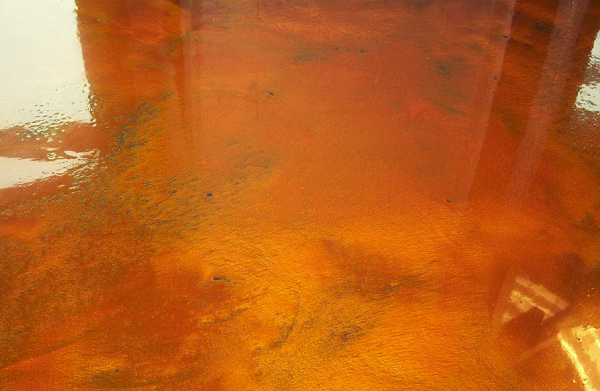
The staff was presented with one final challenge. On the evening of the project’s last day, just hours before the party for the Michigan State-UConn Final Four basketball game, the protective cardboard was removed to reveal a nasty surprise. Unbeknownst to Abstract or the client, the cardboard had become saturated with water that leaked through a doorway, re-emulsifying the wax. Ilitch Holdings project manager James Lavallee responded to the emergency.
“After we lifted the protective covers, we had big areas of hazing in the wax finish,” he remembers. “We sanded down the bad areas and reapplied a new wax coating to the entire area. That was a late night.”
Abstract hit a home run by going above and beyond the call of duty. The firm hopes to land future contracts with Ilitch Holdings. “There was no better time to have something looking right,” Whinnery says.
www.abstract-concrete.com
www.elitecretemi.com
Project at a Glance
Scope of work: Floor for sports bar at Comerica Park in Detroit, Mich.
Contractor: Abstract Concrete, Rochester Hills, Mich.; Brian Whinnery and Dennis Yurconis, partners
Architect and construction manager: Ilitch Holdings Inc., Detroit, Mich.
Project design and management: Ray Rifenberg Sr., Elite Crete of Michigan LLC
